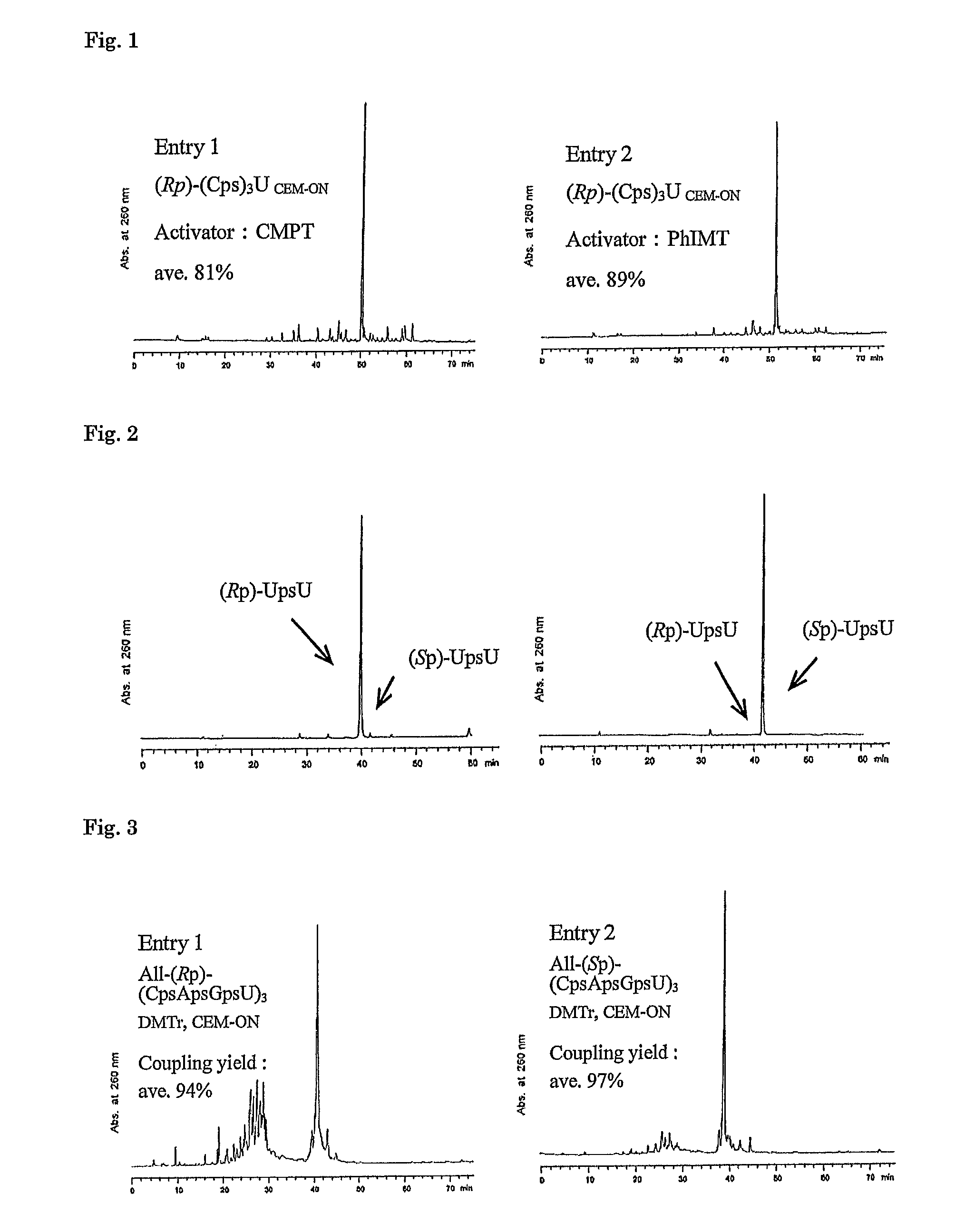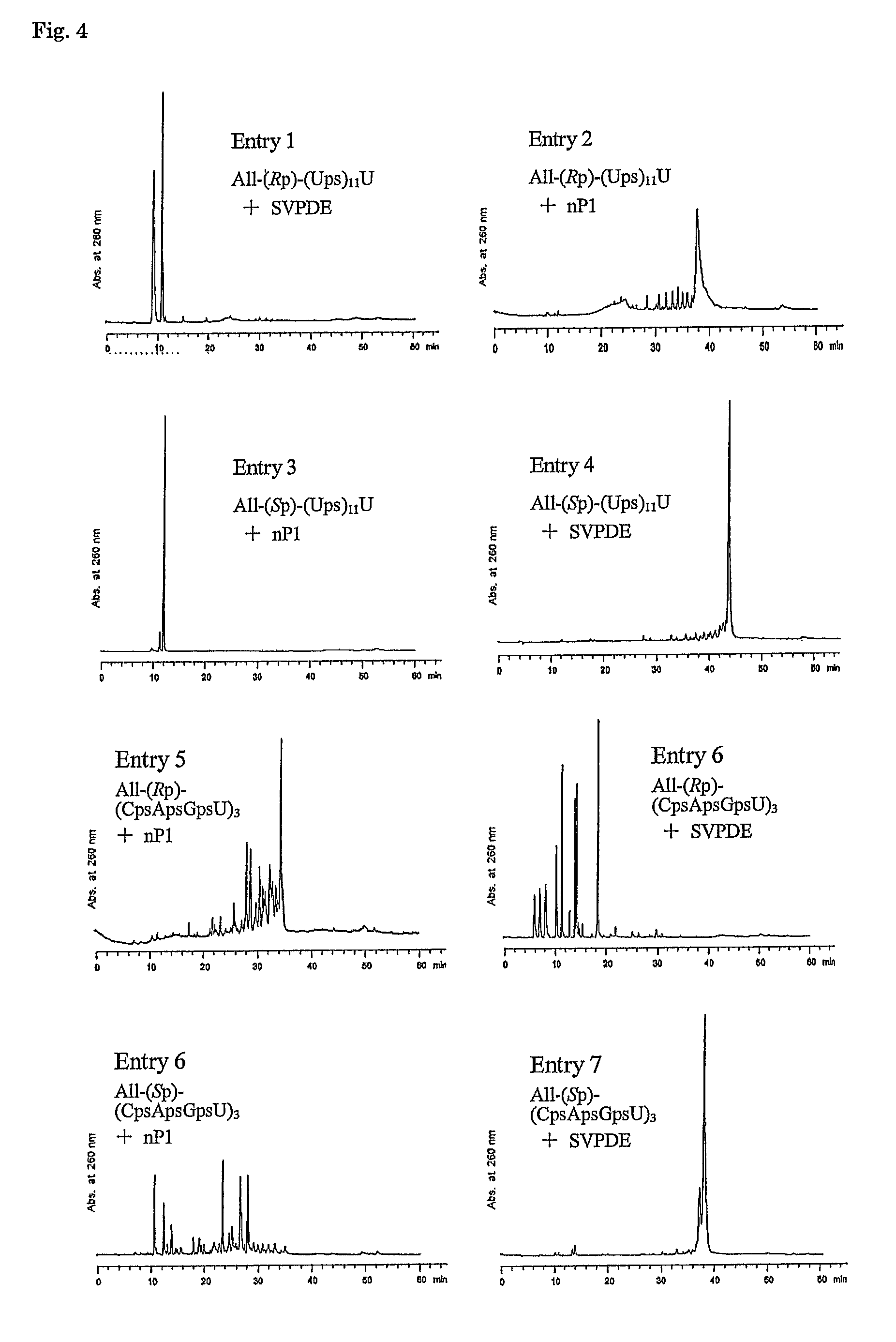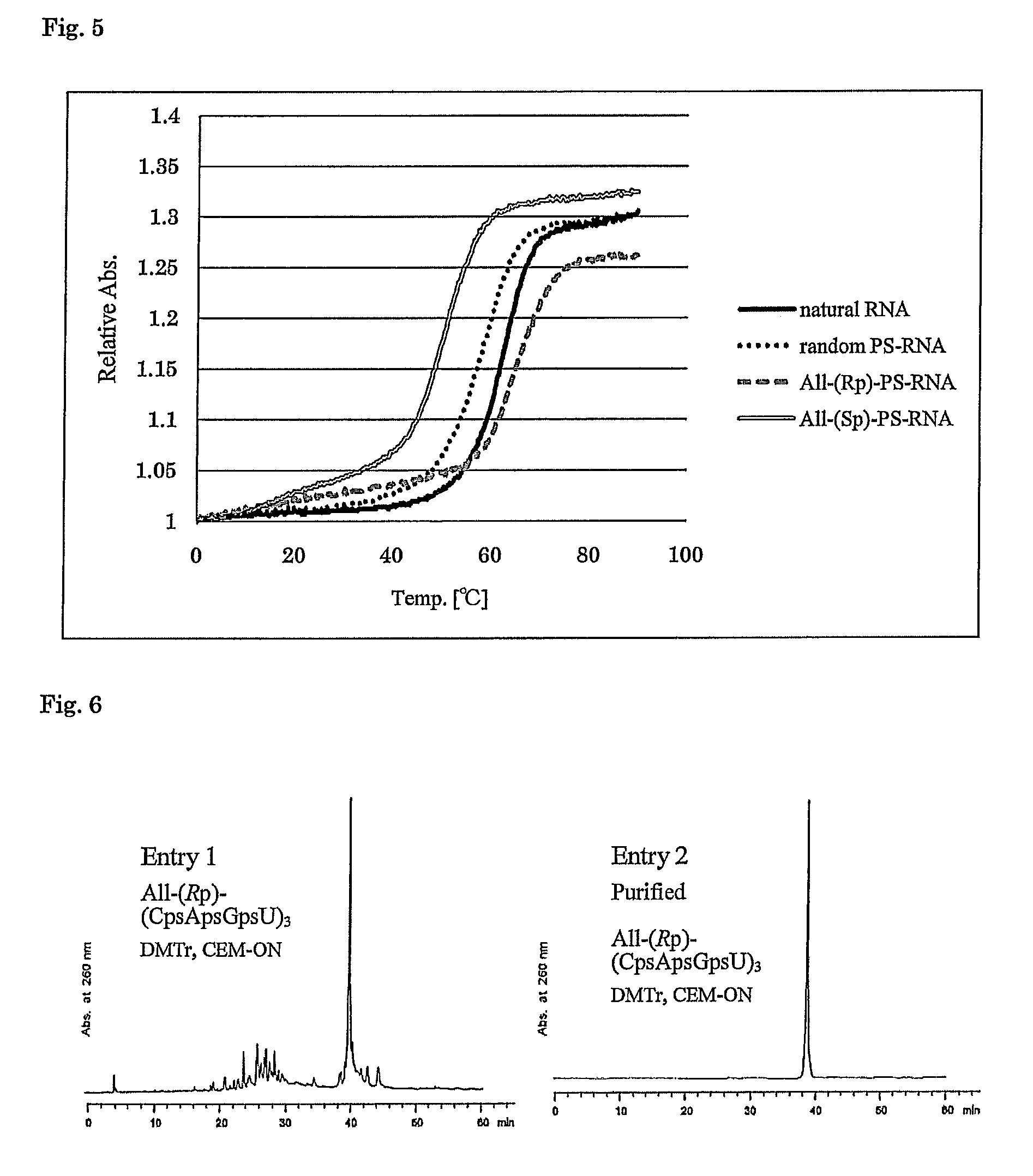Method for preparing ribonucleoside phosphorothioate
a ribonucleoside phosphorothioate and ribonucleoside technology, applied in the field of stereoselective preparation of ribonucleoside phosphorothioate, can solve the problems of low reactivity, insufficient condensing efficiency of synthesis of long-chain oligomers, and unsatisfactory methods, and achieve high stereoselective condensing efficiency, high yield, and efficient synthesized
- Summary
- Abstract
- Description
- Claims
- Application Information
AI Technical Summary
Benefits of technology
Problems solved by technology
Method used
Image
Examples
example 1
(a) O6-Cyanoethyl-N2-phenoxyacetyl-3′,5′-O-(di-tert-butylsilanediyl)-2′-O-(2-cyanoethoxymethyl)guanosine
[0056]
[0057]N2-Phenoxyacetyl-3′,5′O-(tetrisopropyldisiloxane-1,3-diyl)-2′-O-(2-cyanoethoxymethyl)guanosine (11.175 g, 14.9 mmol) was dried by repetition of azeotropy with toluene and dichloromethane to prepare a solution in dichloromethane (100 ml). N,N-Dimethylaminopyridine (DMAP, 0.092 g, 0.75 mmol), triethylamine (8.3 ml, 59.6 mmol) and mesitylenesulfonyl chloride (3.920 g, 17.9 mmol) were added to the solution, and the mixture was stirred at room temperature for 30 minutes. The reaction mixture was washed with saturated aqueous sodium hydrogencarbonate (30 ml×3), and the combined washing solution was extracted with dichloromethane (30 ml×2). The organic layer was dried over anhydrous sodium sulfate, then filtered, and concentrated under reduced pressure. The residue was dried by repetition of azeotropy with toluene and dichloromethane to obtain a solution in dichloromethane (1...
example 2
[0064]
(a) 5′-O-(4,4′-Dimethoxytrityl)-3-O-[(2R,4S,5R)-5-phenyl-tetrahydro-1H,3H-pyrrolo[1,2-c]-1,3,2-oxazaphospholidin-2-yl]-2′-O-(2-cyanoethoxymethyl)uridine [(Rp)]
[0065]5′-O-(4,4′-Dimethoxytrityl)-2′-O-(2-cyanoethoxymethyl)uridine (0.630 g, 1.0 mmol) was dried by repetition of azeotropy with pyridine and toluene to obtain a solution in tetrahydrofuran (5 ml). This solution was added with triethylamine (1.0 ml, 7.1 mmol), and the mixture was cooled to −78° C., and carefully added dropwise with a 0.5 M solution of (4S,5R)-oxazaphospholidine chloride (6 ml, 3.0 mmol) in tetrahydrofuran at the same temperature, −78° C. The mixture was stirred for 1.5 hours with returning it to room temperature, then diluted with chloroform (400 ml), and added with saturated aqueous sodium hydrogencarbonate (100 ml). The organic layer was separated, and then washed with saturated aqueous sodium hydrogencarbonate (100 ml×2), and the combined washing solution was extracted with chloroform (30 ml×2). The ...
example 3
[0077]The following compounds were synthesized in the same manner as that of Example 2 by using 4R,5S-oxazaphospholidine chloride.
(a) 5′-O-(4,4′-Dimethoxytrityl)-3′-O-[(2S,4R,5S)-5-phenyl-tetrahydro-1H,3H-pyrrolo[1,2-c]-1,3,2-oxazaphospholidin-2-yl]-2′-O-(2-cyanoethoxymethyl)uridine [(Sp)]
[0078]5′-O-(4,4′-Dimethoxytrityl)-2′-O-(2-cyanoethoxymethyl)uridine (0.944 g, 1.5 mmol) was added with triethylamine (1.5 ml, 10.5 mmol) and a 0.5 M solution of 4R,5S-oxazaphospholidine chloride (9.3 ml, 4.7 mmol) in tetrahydrofuran, and the mixture was stirred at room temperature for 1.5 hours. The residue was purified by silica gel chromatography [0.30 g of crude product, 3 g of NH silica gel, hexane / ethyl acetate / triethylamine (20:10:0.03, v / v / v→10:10:0.02, v / v / v); and 1.40 g of crude product, 5.5×27 cm, 3.0 g of NH silica gel, hexane / ethyl acetate / triethylamine (20:10:0.03, v / v / v→10:20:0.03, v / v / v)] to obtain the objective substance (0.900 g, 71%, colorless amorphous).
[0079]1H NMR (300 MHz, CDC...
PUM
| Property | Measurement | Unit |
|---|---|---|
| temperature | aaaaa | aaaaa |
| temperature | aaaaa | aaaaa |
| temperature | aaaaa | aaaaa |
Abstract
Description
Claims
Application Information
 Login to View More
Login to View More - R&D
- Intellectual Property
- Life Sciences
- Materials
- Tech Scout
- Unparalleled Data Quality
- Higher Quality Content
- 60% Fewer Hallucinations
Browse by: Latest US Patents, China's latest patents, Technical Efficacy Thesaurus, Application Domain, Technology Topic, Popular Technical Reports.
© 2025 PatSnap. All rights reserved.Legal|Privacy policy|Modern Slavery Act Transparency Statement|Sitemap|About US| Contact US: help@patsnap.com



